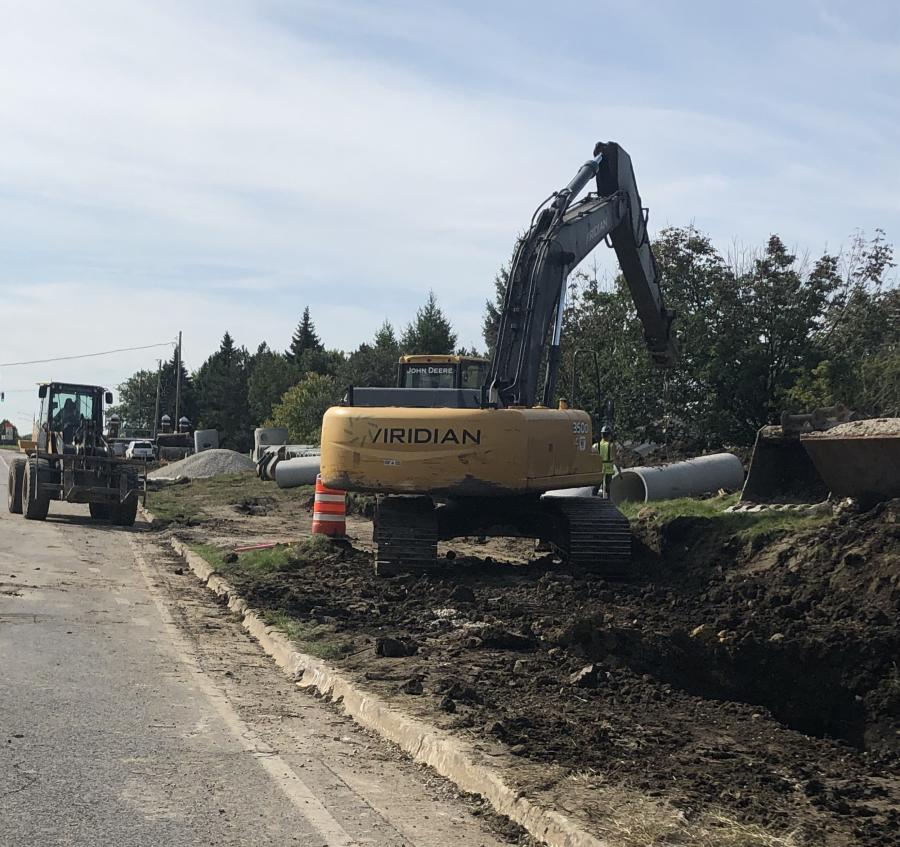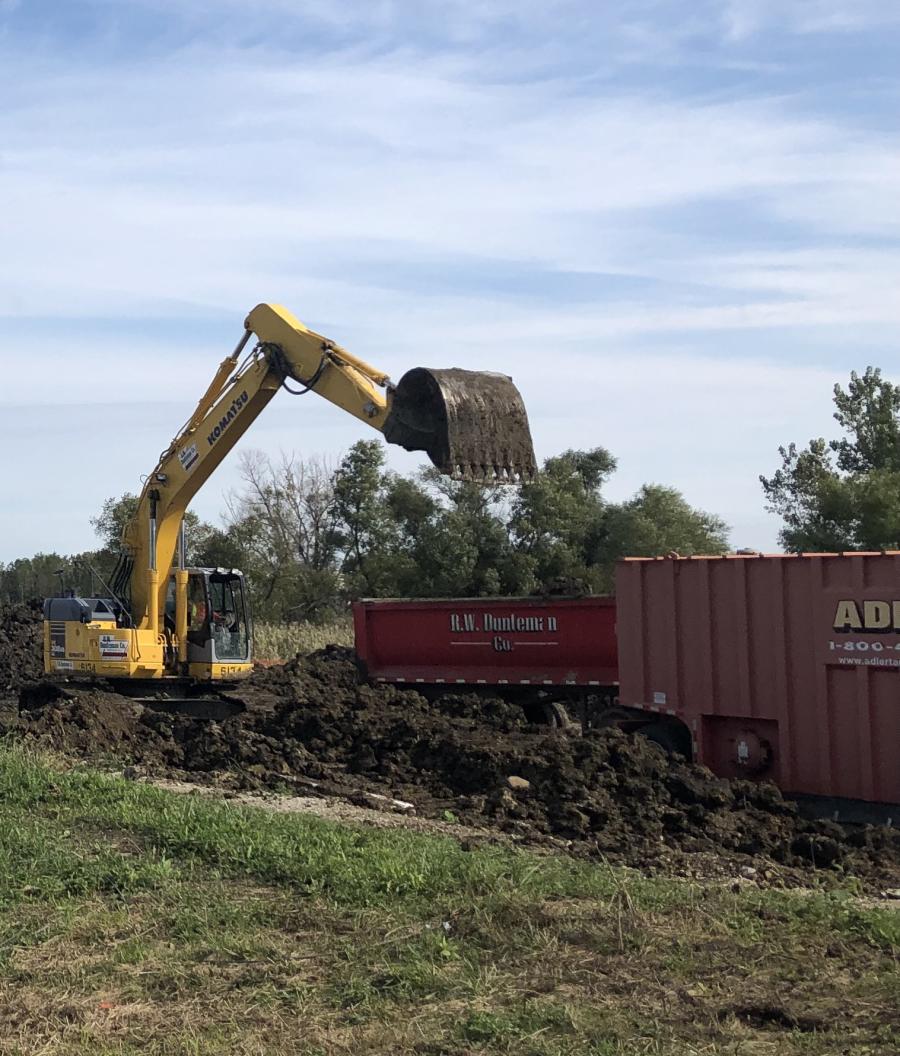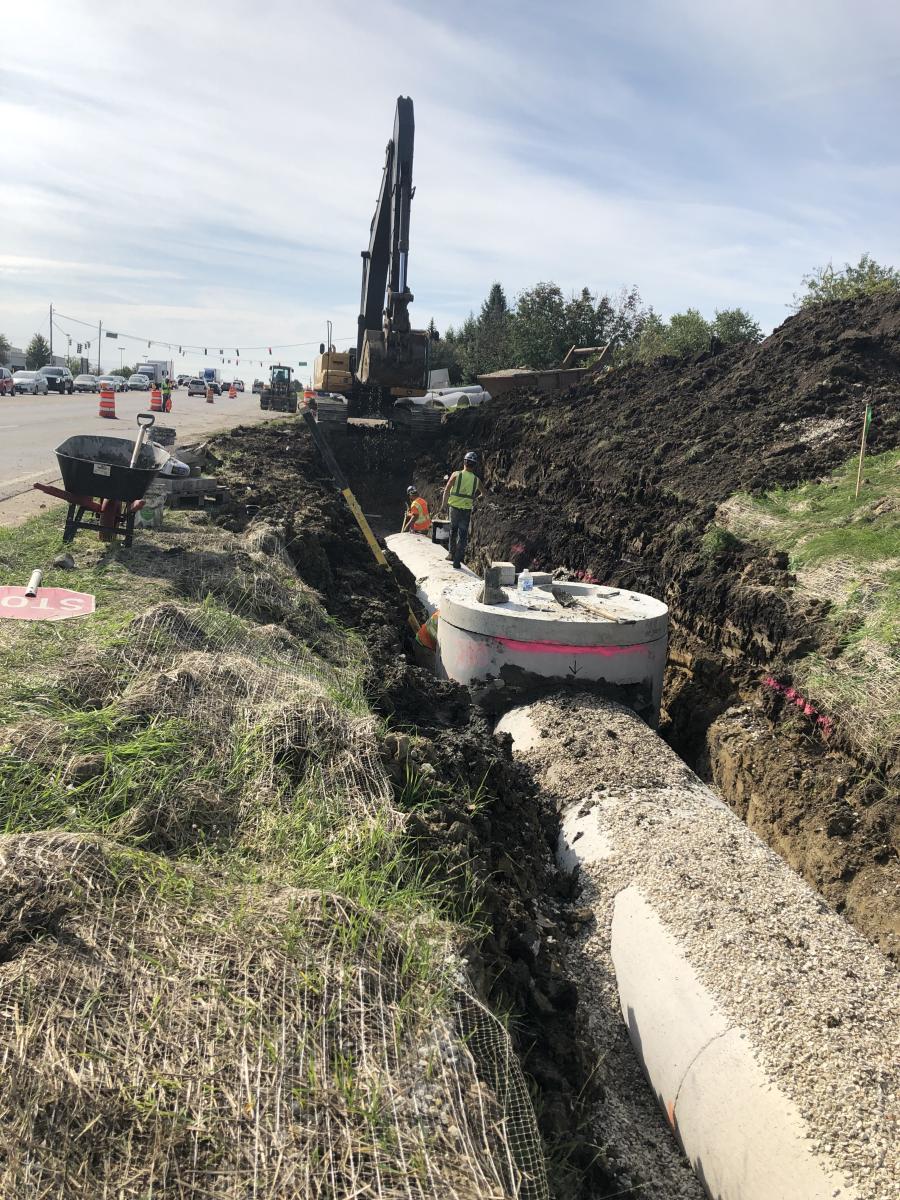The pre-stage benchmarks, which should be completed in early spring, deal with utility relocations; installation of water main and sanitary sewers; placing temporary traffic signals; and widening and drainage.
(R.W. Dunteman Co. photo)
Utility relocations delays prevented crews from starting work on the $68 million I-55 Interchange project on Weber Road in Romeoville, Ill., in 2018, but in early May 2019 operations began in earnest.
The work zone covers Weber Road from 119th Street north/Rodeo Road of the interchange to 135th Street/Romeo Road to the south and 1/2 mi. east and west of Weber Road along I-55. The reconstruction and widening are taking place in Will County, mainly in the Romeoville area and will be completed in late 2021.
The overall improvements are based on adding a third lane to each direction of Weber Road — a concrete road, with modernized traffic signals and a barrier median. The interchange is being rebuilt as a diverging diamond interchange (DDI).
"The purpose of the project is to address safety, operational and capacity deficiencies in the Interstate 55 and Weber Road Interchange project study area," states an Illinois Department of Transportation web page. "This section of Weber Road and the interchange with I-55 are critical commuting links for the region and serve a number of businesses and industries locally. The I-55 at Weber Road interchange was built in 1990. At that time, much of the area around Weber Road was used for farming with a few residential subdivisions."
Will County is responsible for the more than $20 million south contract, awarded to R.W. Dunteman Co. The contract, funded by federal, state and local funds, covers 1.54 mi. in Romeoville from 0.5 mi. south of 135th Street to Normantown Road.
The work is being done in four stages. The pre-stage benchmarks, which should be completed in early spring, deal with utility relocations; installation of water main and sanitary sewers; placing temporary traffic signals; and widening and drainage. This included earth work — topsoil stripping, embankment work and aggregate sub-base installation for temporary pavement.
The road is being rebuilt and widened to three lanes in each direction, with turn lanes at signalized intersections. There will be intersection improvements and new traffic signals on 135th Street and on N. Carillon Drive/Grand Boulevard; the interconnection of new traffic signals with traffic signals at Lakewood Falls Drive and Normantown Road; ground improvement to stabilize roadway in Slough; the installation of an enclosed drainage system and replacement of a box culvert at Slough; and detention ponds for water quality improvement at 135th Street and south end of Slough; improvements to Romeoville water main and sanitary sewer; putting in a 10-ft. wide shared-use path (west side) and 5-ft. sidewalk (east side), all ADA compliant; building a 10 ft. tall, reinforced concrete, stone finish noise wall; retaining wall installation; and roadway lighting improvements at various intersections.

Other improvements consist of new dual left turn lanes for SB & WB traffic and right turn lanes for all legs of the intersections at N. Carillon Drive/Grand Boulevard and 135th Street/Romeo Road.
This new Weber mainline road will have a 12-in. aggregate subgrade improvement and a concrete pavement with 10.5-in. thickness. The 135th Street (west leg), The N. Carillon Drive and Grand Boulevard widening and resurfacing will have a 5-1/4-in. asphalt base course and a 2-in. asphalt surface course, while the 135th Street (east leg) widening and resurfacing will have a 12-in. aggregate subgrade improvement, 8-1/4-in. aggregate subgrade improvement, and a 2-ft. asphalt surface course.
Emsi Oshana, R.W. Dunteman's project manager/superintendent, expects to complete the project in June 2021, but there are challenges to building a section of road across a wetland.
"We'll be excavating almost six feet deep in the muck," said Oshana. "We'll be building a temporary platform and we hired Menard Group USA to put in controlled modulus columns per-design to stabilize the roadway. Then we'll start our embankment. That's going to be a real challenge, dealing with the deep trench excavation in wet conditions. It's going to be a deep excavation. Staging and keeping the work going is important. You can almost call it a land bridge — the road will be sitting atop the columns, designed and spaced five feet apart in each direction and intended to stabilize the wetland conditions of the soil.
A fair amount of the wetlands will be retained.
"We're taking every precaution to ensure that the plants and wildlife that live there are maintained," said Oshana.
While most of the work — excavations and removals — occurred during the day, sewer crews put in some night shifts to be more efficient as extended hours were required.
"It was a tight work zone, but we managed to lease a couple of properties as staging areas," said Oshana. "One is in the middle of the job and another at the southern end. We managed to install the all the storm sewer work and complete the crushing operations to recycle aggregate that we removed."
Stage 1 work focused on rebuilding and widening the west side of Weber Road, with traffic switched to the east and via the temporary pavement, have two lanes of traffic on both sides. The plan is to excavate the existing pavement and replace it, construct the remaining sewer laterals, and finish some of the watermain.
"Road removal will be the easy part of the work, and we'll be using our grinders for that," said Oshana. "We'll recycle it as capping. Most of the concrete curb, sidewalk and miscellaneous concrete structures will be crushed and used as granular embankment."
Excavators and dozers will be equipped with GPS to match the prescribed elevation for the placement of the aggregate stone, as will the pavers.
Stage 2 had crews working into June or July to build the new lanes.
"I'll reconstruct the median and left turns in Stage 3, which should go fairly smoothly," said Oshana. "Everything should be wrapped up in December 2021 unless there are unforeseen conflicts."
Subcontractors include Thorn Electric for the mast arms and traffic signals; Aretha Construction for cast-in-place box culverts and sound walls; Viridian Construction for storm sewers and watermain, and Del Toro Landscaping for topsoil re-spread, seeding, sodding and plantings.
The road crews are expecting to remove 16,000 ft. of curb, 30,000 sq. ft. of sidewalks, and 42,000 sq. yds. of asphalt.
New materials to be brought in for the project should include 30,000 cu. yds. of reinforced concrete.
R.W. Dunteman mainly uses Cat and Komatsu equipment — excavators, dozers, loaders and graders, with the paving and grinding equipment manufactured by Wirtgen.
"Wear and tear are your typical hydraulic hose failures and clogging of the motors with debris," said Oshana. "Our equipment is new and well maintained. Our in-house mechanical team is out there at any hour to repair the majority of the problems. You have to do your typical oil changes and follow your routine maintenance schedules. Our head mechanic coordinates with me on the amount of equipment that I have and if it can be looked at during the day, off-hours, and weekends."
The company purchases and rents Komastu and Wirtgen equipment from Roland Machinery Company; Cat equipment from Altorfer Cat; and John Deere equipment from West Side Tractor. The dealerships are providing mechanical support for pieces under warranty.
Clear communications and mutual respect, Oshana explained, is the key to good relations with dealerships
"Service is important, as is standing by your product," he said.
Today's top stories






















